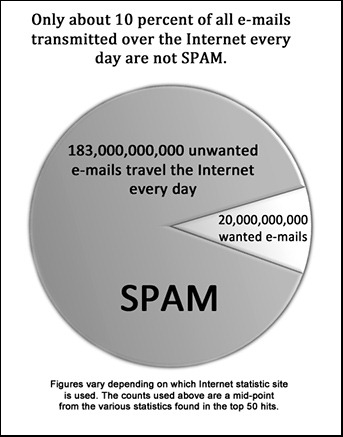SPAM: 183 billion per day
The figures vary depending on which Internet statistics site you check, but it seems that for the first quarter of 2010 (January to March) somewhere between 164 and 202 billion items of SPAM e-mail were transmitted over the Internet every day. The average of these two counts is 183 billion, so let’s assume then—just so that I have the one figure to work with—that 183 billion items of SPAM per day are transmitted over the Internet.

- 7,625,000,000 (7.625 billion) every hour; or
- 127,083,333 (127 million) per minute; or
- 2,118,055 (2.118 million) per second.
With all this unwanted e-mail SPAM continuously being moved around the Internet consuming valuable network space (‘bandwidth’ for the IT types reading this) it makes you wonder how anything else can ever get done on the Internet.
It should also be noted that this is the count of SPAM on the public Internet and does not include SPAM that is initiated or re-transmitted inside companies and businesses using their internal e-mail systems.

>> According to a report on e-mail and SPAM by Microsoft a staggering 97 percent of all e-mails sent are unwanted.
>> It is estimated that transmitting and handling SPAM cost businesses US$130 billion in 2009.
>> Mondays are the busiest day of the week for SPAM. Saturdays are the quietest.
>> It takes the average spammer two and a half weeks from when they first discover and harvest your e-mail address to when they send you your first SPAM e-mail. This is twice as quick as they were five years ago.
>> Almost all e-mail address harvesting (to get e-mail addresses to send SPAM to) is now done by bots (robot programs) scanning Web site data, viruses, and honey-pot Web sites. A honey-pot Web site is one that you get suckered into going to and then that site runs a stealth program to search for e-mail addresses stored on your computer.
>> The sole purpose of about 15 percent of SPAM is to bounce around the Internet and collect more e-mail addresses to send SPAM to. This happens as people forward ‘really interesting’ e-mails to others, who then forward them again, and in so doing the list of valid e-mail addresses that can be harvested from the To: and Cc: fields of the e-mail threads grows.
>> Every time your email address is harvested you can expect to be sent about 850 SPAM messages over a 12 to 16 month period from that particular harvesting. However, thanks to gateway and local SPAM filtering engines ‘shooting them down’ mid-flight, only about 7 percent of this SPAM is likely to end up in your e-mail inbox.
>> Gateway and local mail client SPAM filtering engines are getting very good at identifying and filtering SPAM. However even though the percentage of SPAM identified and filtered by SPAM filtering engines improves every year, the sheer number of SPAM messages being generated means the absolute number of SPAM e-mails that get through to your inbox has not decreased since 1999.
What I would like to know is what percentage of all Internet traffic is taken by e-mail being transmitted. In fact it would be interesting to know Internet usage broken down into e-mail, Web surfing, torrent downloads, etc. I might have a look around and see if I can find this data. If I do then you can expect a quick posting on it—like it or not (*grin*).

